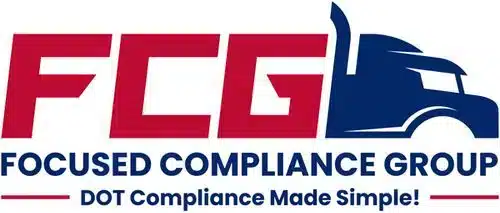When it comes to Hours of Service (HOS) regulations, there’s often confusion surrounding the use of Personal Conveyance (PC) in commercial motor vehicles (CMVs). Many drivers and fleet managers alike struggle to understand when they can use their vehicle for personal reasons without violating federal regulations. At Focus Compliance Group, we’re here to clear up the rules and dispel some common misconceptions to help you stay compliant and avoid costly mistakes.

What is Personal Conveyance (PC)?
Personal Conveyance (PC), as defined by FMCSA personal conveyance guidelines, refers to the use of a commercial motor vehicle (CMV) for personal, non-business-related purposes while the driver is off duty. According to the Federal Motor Carrier Safety Administration (FMCSA), PC is allowed when the vehicle is being used for personal tasks unrelated to the driver’s job or the carrier’s business. This includes activities such as going to a hotel, getting food, or driving to a personal destination. Commuting between the driver’s terminal and their residence is a recognized use of personal conveyance, provided the distances are reasonable for adequate rest.
While PC is permitted under specific circumstances, it’s important to note that its use must not interfere with the driver’s rest period or extend driving hours in a way that would violate HOS rules. The motor carrier’s policies play a crucial role in determining the use of personal conveyance, while still adhering to FMCSA guidelines. Let’s take a closer look at the regulations and when personal conveyance can—and cannot—be used.
Definition and Purpose
Personal conveyance is the movement of a commercial motor vehicle (CMV) for personal use while off duty. The purpose of personal conveyance is to allow drivers to use their CMV for personal activities while they are off duty and relieved of their responsibilities as a motor carrier. According to the Federal Motor Carrier Safety Administration (FMCSA), personal conveyance provides drivers with the flexibility to use their CMV for personal tasks, such as traveling to a restaurant, hotel, or their residence, without it being considered on-duty time. This ensures that drivers can attend to personal needs without violating hours of service regulations.
FMCSA Regulations on Personal Conveyance for Commercial Motor Vehicle
The FMCSA outlines the rules for Personal Conveyance in 49 CFR §395.8 (Hours of Service of Drivers). According to the FMCSA, the following criteria must be met for Personal Conveyance to be applicable:
-
Off Duty: The driver must be off duty and not engaged in any work-related tasks.
-
Non-Commercial Use: The vehicle must be used for personal purposes only. This means the vehicle cannot be used to advance the carrier’s business interests, such as traveling from one worksite to another. Commuting between the driver’s terminal and their residence is a recognized use of personal conveyance, provided the distances are reasonable for adequate rest.
-
No Impact on Rest: Using the CMV for personal conveyance must not interfere with the required rest period, and it cannot extend the driver’s driving time beyond the limits outlined in the HOS regulations. Additionally, the FMCSA emphasizes that the time a driver spends traveling to a safe location must allow them adequate time to rest according to federal regulations.
It is ultimately up to the motor carrier’s policies to determine the use of CMVs for personal purposes, while still adhering to FMCSA guidelines.
Eligibility and Requirements
To be eligible for personal conveyance, a driver must be operating a commercial motor vehicle (CMV) for personal use while off duty. This means the driver must be relieved from work and all responsibility for performing work by the motor carrier. The motor carrier’s policies can further define and restrict the use of personal conveyance, ensuring compliance with FMCSA guidelines. The use of personal conveyance is strictly for personal purposes and not for the commercial benefit of the motor carrier.
The Federal Motor Carrier Safety Administration (FMCSA) has set specific requirements for using personal conveyance. These include:
-
The driver must be off duty and not engaged in any work-related activities.
-
The CMV must be used solely for personal use.
-
The driver must not be transporting any cargo or passengers for the commercial benefit of the motor carrier.
-
The CMV must be operated safely and in accordance with all applicable laws and regulations.
By adhering to these requirements, drivers can ensure they are using personal conveyance correctly and in compliance with FMCSA regulations.
What Activities Qualify as Use of Personal Conveyance?

Here are examples of activities that can qualify as Personal Conveyance:
-
Traveling to a hotel or restaurant: After a long day of driving, you’re allowed to use your CMV to travel to a hotel, restaurant, or other personal destinations, as long as you are off duty and not working.
-
Returning to a terminal or yard: If you’re off duty and near your home or base location, you may use the vehicle to travel to the terminal or company yard to park it for the night.
-
Driving to your personal home: If you’re off duty, you can drive the vehicle to your personal residence, provided you’re not using the vehicle to conduct business-related activities.
-
Using the CMV for personal tasks unrelated to the driver’s job or the carrier’s business, including passenger carrying vehicles, as long as the vehicle is not being used to transport passengers for commercial purposes.
-
Using the CMV for personal tasks unrelated to the driver’s job or the carrier’s business, including property carrying vehicles, as long as the vehicle is not being used to transport property for commercial purposes.
When is PC Not Allowed While Off Duty?
While Personal Conveyance offers flexibility, there are clear limitations on its use. Here are some examples of activities that do not qualify as Personal Conveyance:
-
Repositioning the vehicle for the carrier: If you’re moving the vehicle to a location where it will be used for a business-related task—such as repositioning a truck to load or unload goods—this is not personal conveyance, even if you’re technically off duty.
-
Traveling to a pickup or delivery location: You cannot use PC to drive from your home to a pickup or delivery site, as this would be considered part of the driving time for work.
-
Using PC to “extend” driving hours: If you are using PC to continue driving past your allowed driving limits, even if you are off duty, this is not allowed. PC cannot be used to circumvent HOS restrictions.
-
Moving the vehicle at the request of a safety official during a driver’s off-duty time: This is not considered personal conveyance.
Hours of Service and Personal Conveyance
Personal conveyance is considered off-duty time and does not impact a driver’s hours of service. However, it is crucial for drivers to still comply with all applicable hours of service regulations, including minimum off-duty periods and required restorative rest.
Drivers can use personal conveyance to travel to a safe location, such as a motel or truck stop, to obtain the required rest. Despite being off duty, drivers must log their time accurately and ensure they are adhering to all hours of service regulations. This ensures that the use of personal conveyance to obtain required rest does not inadvertently lead to violations.
Load Requirements and Personal Conveyance
The FMCSA guidance on personal conveyance has relaxed the strict requirement for a driver’s vehicle to be “empty” or “unladen.” However, drivers must still comply with all applicable load requirements and regulations.
Drivers can use personal conveyance even with a laden vehicle, provided the load is not being transported for the commercial benefit of the motor carrier at that time. It is essential for drivers to ensure that the load is properly secured and that the vehicle is operated safely. This approach allows for flexibility while maintaining safety and compliance.
Mileage Limits and Personal Conveyance
There is no specific mileage limit on the use of personal conveyance as per FMCSA guidelines. However, it is crucial for drivers to adhere to the general principles of personal conveyance and ensure that their use of the CMV does not interfere with their required rest periods or extend their driving hours. The FMCSA encourages motor carriers to establish personal conveyance limitations to maintain compliance and safety. These limitations can include banning the use of a CMV for personal conveyance purposes, imposing a distance limitation, or prohibiting personal conveyance while the CMV is laden. By setting these boundaries, motor carriers can help ensure that personal conveyance is used appropriately and safely.
Personal Property and Personal Conveyance
When using personal conveyance, drivers are allowed to transport their personal property in the CMV. However, it is important to note that the transportation of personal property must not be for the commercial benefit of the motor carrier. The FMCSA guidance on personal conveyance provides additional flexibility for fleets that choose to allow their drivers to utilize off-duty driving or personal conveyance. This means that while drivers can carry their personal belongings, they must ensure that these items are not related to any commercial activities of the motor carrier. This distinction helps maintain the integrity of personal conveyance and ensures compliance with FMCSA regulations.
Company Policies and Personal Conveyance
Motor carriers have the authority to establish personal conveyance limitations, such as prohibiting the use of a CMV for personal conveyance purposes or imposing a distance limitation on personal conveyance. The motor carrier’s policies can further define and restrict the use of personal conveyance, ensuring compliance with FMCSA guidelines. They can also set policies and procedures for the use of personal conveyance, including requirements for logging time and complying with hours of service regulations.
Drivers must adhere to their motor carrier’s policies and procedures for personal conveyance, as well as all applicable laws and regulations. Non-compliance with these policies can result in disciplinary action, including termination of employment. It is crucial for drivers to understand and follow their company’s rules to avoid any potential issues.
By understanding and following these guidelines, drivers can use personal conveyance effectively and in compliance with both FMCSA regulations and their motor carrier’s policies.
Tracking and Compliance
To ensure compliance with personal conveyance rules, motor carriers must establish a robust system for tracking and monitoring the use of personal conveyance. This can be achieved by using electronic logging devices (ELDs) to accurately record personal conveyance time and mileage. Additionally, motor carriers should provide comprehensive training to drivers on the proper use of personal conveyance, ensuring that they understand the guidelines and limitations. By implementing these measures, motor carriers can effectively monitor personal conveyance use and ensure that drivers are adhering to the established rules, thereby maintaining compliance with FMCSA regulations.
Violations and Penalties
Violations of personal conveyance rules can lead to significant penalties, including fines and points assessed against the driver’s safety record. The FMCSA may conduct audits and inspections to ensure compliance with personal conveyance rules, and any misuse can result in disciplinary action. Drivers who misuse personal conveyance may face consequences such as termination of employment. Additionally, motor carriers who fail to establish and enforce personal conveyance policies may also be subject to penalties and fines. It is crucial for both drivers and motor carriers to understand and adhere to personal conveyance rules to avoid these potential violations and maintain a safe and compliant operation.
Common Misconceptions About PC

Despite clear regulations, there are several misconceptions about Personal Conveyance that can lead to violations if not properly understood. Let’s clear these up.
-
Misconception: “I can always drive my truck as long as I’m off duty.”
Reality: No, you cannot. Personal Conveyance only applies when you are off duty and the vehicle is used strictly for personal reasons. It is important to understand that personal conveyance rules apply specifically to commercial motor vehicles and must be adhered to in order to avoid violations. If you are on duty driving, performing work-related activities or using the vehicle for business purposes, it does not qualify as personal conveyance, even if you’re technically off duty.
-
Misconception: “Personal Conveyance counts toward my driving hours.”
Reality: When you use Personal Conveyance, the time does not count toward your driving hours. However, the key here is that you must be using the vehicle for personal reasons—if you are not, then the time will count toward your driving hours.
-
Misconception: “I can drive anywhere I want while on Personal Conveyance.”
Reality: No, the vehicle can only be used for personal purposes, and only when it doesn’t interfere with your required rest period. For instance, if you need to drive the vehicle to park it at a safe location or to get some rest, that may be acceptable. But, driving it for long distances for personal errands while off duty would likely be considered a violation.
-
Misconception: “If I use the truck for Personal Conveyance, I don’t need to record the time.”
Reality: Personal Conveyance must be properly documented in your Electronic Logging Device (ELD) or paper logbook. When using PC, it should be clearly marked as “Personal Conveyance” in the log so that inspectors can identify that the time was not part of your driving hours.
Tips for Staying Compliant with PC Rules
-
Document Everything: Always clearly mark Personal Conveyance time in your logbook or ELD. If you are using PC, make sure to track the time accurately to avoid confusion or violations during inspections.
-
Use Common Sense: Just because something is technically “personal” doesn’t mean it qualifies under the rules. Use the vehicle only for true personal activities and never for work-related tasks. When commuting between the driver’s terminal and his or her residence, ensure the distance is reasonable to obtain restorative rest.
-
Consult Your Fleet Manager: If you’re ever uncertain about whether an activity qualifies as Personal Conveyance, check with your fleet manager or compliance officer. It’s better to ask than risk a violation.
-
Stay Informed: FMCSA regulations can evolve. Make sure you are up-to-date on any changes to Personal Conveyance rules to stay compliant.
Final Thoughts
Understanding and adhering to the rules surrounding Personal Conveyance can help you stay compliant with FMCSA regulations while also enjoying some flexibility in your schedule. However, using your CMV for personal reasons requires caution and careful documentation. By following the guidelines, avoiding common misconceptions, and staying vigilant, you can safely navigate Personal Conveyance rules without risking violations.

If you need more detailed guidance on HOS compliance or Personal Conveyance rules, feel free to reach out to Focused Compliance Group. Our team is here to help you stay compliant and keep your fleet running smoothly.
